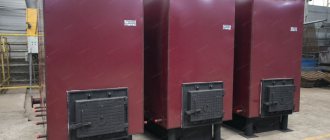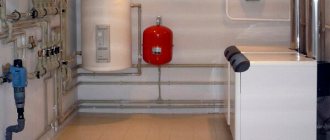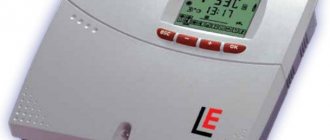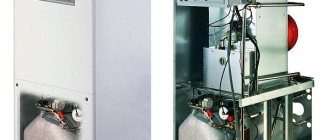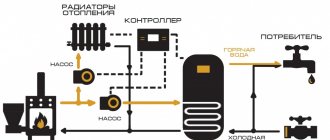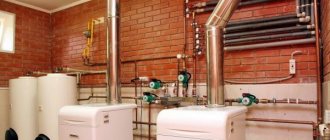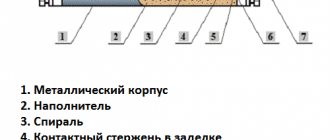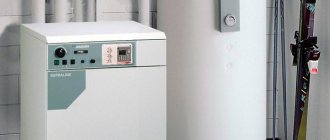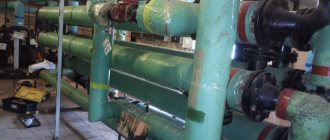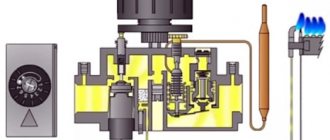Any industrial enterprise, regardless of its profile and size, needs heat to heat its production areas. Moreover, many technological processes depend on the availability of thermal energy, for the generation of which industrial gas boilers are traditionally used. Thermal energy is supplied to production in two forms: hot water or steam.
Types of industrial gas boilers for heating
The following types of devices are available for sale:
- Hot water.
- Steam.
- Cogeneration.
They differ in the following features:
- Water temperature. Industrial devices heat a liquid or create dry steam.
- Type of heat exchanger.
- Efficiency and heat transfer efficiency.
Many brands from Europe and Russia are engaged in the production of industrial boilers.
Both ready-made boiler rooms made from modules and free-standing units are available to consumers. The hot water type is in greatest demand. It has the following characteristics:
- Specifics of heating the working substance. Boilers can use either a primary device that completely surrounds the burner, or a smoke channel with a non-standard design.
- Number of heat exchangers - heating systems are equipped with 1 element. To ensure uninterrupted hot water supply, an indirect heating boiler is installed. The average tank volume is 2500 l.
- Adaptation for operation on liquefied gas, oil or diesel fuel.
Hot water boilers operate on the same principle as domestic models. The only difference is the increased power, which reaches several mW.
Steam units can heat the liquid to a boiling point. The workflow is carried out in 2 stages:
- Increasing the water temperature to 100°C. When the coolant begins to boil, it moves into the separator and is cleaned of moisture particles.
- The generated dry steam is sent for reheating.
An industrial steam boiler solves 2 problems:
- Provides heating for the facility.
- Produces steam for factories.
To increase efficiency, the devices have smoke recirculation. During the heating process, air is directed into the heat exchanger rather than being exhausted outside.
There are the following types of steam equipment:
- Fire tube boiler is an outdated type of heating system with many disadvantages. Combustion products move through many tubes, which are located inside the housing and surrounded by coolant. The power of the units is limited to 360 kW. A pressure of 1 MPa is used to supply the working substance.
- Water-tube models - steam surrounds the structures in which the coolant moves, which contributes to high efficiency. A transverse or longitudinal drum is installed inside the boiler.
Cogeneration heat generators free up resources for the heating system and hot water supply, and then produce electricity. Their advantage is high efficiency, which is up to 90%. Electricity is generated using a piston engine.
The best known manufacturers and models: characteristics and prices
There are many versions of the best industrial boilers published online, since the choice on the market is very wide. However, in many ratings, the following installations for the production of heat and steam are present at various locations.
Buderus Logano SK655/SK755
Two lines of universal boilers: SK655 with a power range from 120 to 360 kW and SK755 - from 420 to 1,850 kW. Low-temperature water heating (up to 110 °C) units running on diesel fuel, liquefied and natural gas. Minimal heat loss and almost complete combustion of fuel bring efficiency to 93% and minimize emissions into the atmosphere. Used in public utilities and thermal power plants. Manufacturer – Belgium.
Cost: 180,000-1,300,000 rubles.
Bosch Unimat UT-M
Universal fire-tube water heating boilers of a three-pass design, operating on gas and diesel fuel. The series is represented by capacities from 750 to 1,920 kW, produces high-temperature coolant (up to 190 ° C) when retrofitted with an economizer and a condensing heat exchanger, the efficiency can be increased to 105%. They are used in city and regional boiler houses, they can work in cascade and for technological purposes in industrial enterprises. Developed in Germany, production in Russia.
Viessmann Vitoplex 100
German hot water boilers with a power from 110 to 2,000 kW, two-pass design reaches an efficiency of 95%. Innovative burners allow you to burn liquid fuel (waste oil) and gas with virtually no emissions into the atmosphere. Coolant temperature up to 110°C. Small size, simple operation and maintenance-friendly design. Suitable for medium-sized boiler houses. The price depends on the configuration.
Cost: 410,000-2,900,000 rubles.
ACV R 200
Solid fuel wood boiler, produces a power of 200 kW, non-volatile, with a three-pass open combustion chamber. It also effectively burns peat, fuel briquettes and pellets with an efficiency of 80%; when retrofitted, it can operate on liquid fuel (waste fuel) and gas. The coolant temperature is 90°C. Convenient for heating small production facilities (heats up to 1,600 m2) away from gas mains, very resistant to burnout (thick-walled). Manufacturer: Belgium.
Cost: 410,000-1,100,000 rub.
The market for industrial boilers is filled not only with imported developments; there are domestic manufacturers who produce equipment that is less efficient in some respects, but is more adapted to our fuel realities.
Advantages and disadvantages
Industrial boilers are in demand in the following fields of activity:
- Production.
- Agriculture.
- Organization of heating in rooms of different heights.
The main advantages include:
- High efficiency, which exceeds consumption.
- Minimal risk of heating system deformation. Since the coolant is not brought to a boil, the possibility of loss of integrity is eliminated.
- Ability to operate on any type of liquid fuel.
- Using direct flow of water.
- The presence of climate sensors that configure the system.
- Compatible with block-modular boiler houses.
- Anti-scale support.
- Ergonomics.
- Wide range of models.
- Independence from the power grid.
- Easy installation and condition check.
The disadvantages include:
- Rapid consumption of energy resources.
- High price. Most models are sold at an inflated price, so consumers are forced to turn to direct suppliers.
- Risk of gas explosion if the burner accidentally goes out. To avoid such troubles, it is important to choose devices with a self-diagnosis system. It includes thermostats and sensors that monitor the intensity of combustion.
Operating conditions
For uninterrupted operation of the equipment, a connection to the gas supply is required. Such units are suitable for the following objects:
- Tsekhov.
- Warehouses.
- Utilities premises.
- Office buildings, buildings.
- Indoor stadiums, grounds and training grounds.
The popularity of blue fuel is due to its low cost, so such boilers are superior to other types in terms of efficiency. Their design includes a burner from which gas comes, as well as a copper heat exchanger.
In addition, the equipment contains a steam pump, a pressure gauge that measures fuel pressure, and a thermometer that is used to estimate the current temperature. The working fluid is in a special reservoir.
How is heating carried out?
The operating principle of industrial boilers is to burn gas with subsequent preparation of the coolant. Despite the different internal design and set of functions, the equipment operates according to an identical scheme. The key components of the system are the heat exchanger and burner.
Initially, the fuel passes through the second element, is ignited by a spark and begins to heat the device in which the liquid circulates.
If steel is used to make the burner, then the heat exchanger is made of copper, stainless steel or carbon alloys.
Depending on the type of fuel supply, the first ones are:
- Injection. Capable of sucking in gas and air.
- Inflatable. Forced draft is used to pump oxygen.
- Diffuse. Fuel is supplied using special channels.
Boilers require high temperatures to operate. Heat resistance is ensured by steel elements with manganese, chromium and other alloying inserts. The walls are reinforced with corrugated covering and a layer of insulation.
In the chambers of water heating systems there are 1 or 2 devices through which liquid moves. Steam models have screens and a heat exchanger that produces energy.
A separator is located in the firebox. A valve is used to protect equipment from explosions and damage. It is installed on the back wall of the device. The mechanism is triggered when pressure readings deviate from the permissible norm.
Installation of water heating boilers for home
All modern household gas boilers in the range of 9 - 30 kW for heating an area of up to 300 m2 are water-heating, that is, the coolant of the heating system circulates through them.
The water heating circuit is made in the form of a water jacket or a tubular heat exchanger.
A typical hot water boiler consists of:
- combustion chamber: open or closed;
- modulating or regular burner;
- heat exchanger for each heating circuit: heating and domestic hot water;
- circulation pump for coolant;
- centrifugal fan in closed devices for air supply;
- control and automatic safety unit.
The smoke exhaust system is carried out according to the recommendations of the boiler manufacturer. The best systems for closed fireboxes are a coaxial chimney, which is purchased separately and does not require vertical exhaust gases through the roof of the building.
Maintenance of hot water gas boilers in a private house is carried out according to schedule cards, which are provided by service or commissioning organizations.
Improvement of gas industrial boilers
Representatives of this group are fully automated. They are controlled by an electronic unit and support independent “loading” of fuel.
Advanced releases are equipped with a modulating burner that changes the flame intensity based on environmental conditions. To ensure that the device performs its functions without failure, manufacturers install the following components:
- Automatic gas supply system. Can operate in 2 modes with main and liquefied fuel. The built-in sensor detects the current pressure and turns off the device if it reaches the desired value.
- Safety features. They are a complex of electronic devices that control the supply and pressure of fuel, the flame on the burner, and the temperature of the coolant.
Errors in domestic hot water boilers
All hot water boilers operating on gas fuel have a single technological principle for heating the coolant and must meet state requirements for safe operation.
The most common errors of hot water boilers:
- Torch breakage on the burner device. This failure is usually caused by high parameters of vacuum in the furnace and the rate of supply of the torch to the combustion mouth, as well as low pressure in the gas network.
- High pressure in the heating circuit, exceeding the value provided by the regime map. The most common reasons for such an error may be: a non-working circulation pump, a leak in the network, a clogged heat exchanger and convective heating surfaces of the boiler.
- High coolant temperature due to low circulation in the boiler. Failure can occur due to poor pump operation, non-working temperature sensors in the boiler control unit, forgotten heating surfaces due to scale.
- Malfunction of the electronic gas shut-off valve system.
Hot water gas boilers are the most common heating sources in individual heating systems of domestic and industrial facilities.
They have the highest efficiency indicators with efficiency up to 92%, the ultimate level of automation of thermal processes - 100%, modulation from 30 to 100% and high availability.
